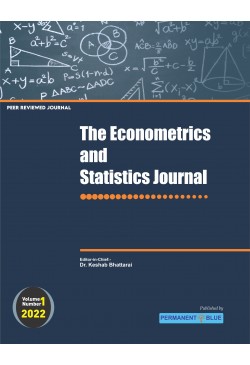
The Econometrics and Statistics Journal
Frequency :Bi-Annual
ISSN :3048-7048
Peer Reviewed Journal
The Econometrics and Statistics Journal: is a single blind peer-review journal the official journal of the theoretical and computational Econometrics, Financial Econometrics, Statistics, Methodological Statistics, and Applied Statistics. It publishes research papers in all aspects of econometrics and statistics. Emphasis will be given to theoretical and methodological papers containing substantial econometrics derivations. Topics of interest includes the estimation of econometric models and related inference, model selection, measurement error, panel data, time series analysis, Bayesian methods, Applied Econometrics, Financial Econometrics, Methodological Statistics, Theoretical Statistics. Papers dealing with computational and technical elements will be encouraged. It may considers articles on complex data sets with such statistical methodology in different areas such as Medical Sciences, Epidemiology, Biology, Psychology, Climatology, Social Sciences, Communications, etc.
TESJ INSTRUCTIONS FOR AUTHORS
Part A: Econometrics. Emphasis is given to methodological and theoretical papers containing substantial econometrics derivations or showing a potential of a significant impact in the broad area of econometrics. Topics of interest include the estimation of econometric models and associated inference, model selection, panel data, measurement error, Bayesian methods, and time series analyses. Simulations are considered when they involve an original methodology. Innovative papers in financial econometrics and its applications are considered. The covered topics include portfolio allocation, option pricing, quantitative risk management, systemic risk and market microstructure. Interest is focused as well on well-founded applied econometric studies that demonstrate the practicality of new procedures and models. Such studies should involve the rigorous application of statistical techniques, including estimation, inference and forecasting. Topics include volatility and risk, credit risk, pricing models, portfolio management, and emerging markets. Innovative contributions in empirical finance and financial data analysis that use advanced statistical methods are encouraged. The results of the submissions should be replicable. Applications consisting only of routine calculations are not of interest to the journal.
Part B: Statistics. Papers providing important original contributions to methodological statistics inspired in applications are considered for this section. Papers dealing, directly or indirectly, with computational and technical elements are particularly encouraged. These cover developments concerning issues of high-dimensionality, re-sampling, dependence, robustness, filtering, and, in general, the interaction of mathematical methods, numerical implementations and the extra burden of analyzing large and/or complex datasets with such methods in different areas such as medicine, epidemiology, biology, psychology, climatology and communication. Innovative algorithmic developments are also of interest, as are the computer programs and the computational environments that implement them as a complement.
The submission of a paper implies the author’s assurance that the paper has not been published and that it has not been submitted simultaneously for publication elsewhere.
All articles submitted to this journal are peer-reviewed. TESJ has a single blind peer-review process in which the reviewers know who the authors of the manuscript are, but the authors do not have access to the information on who the peer reviewers are.
The manuscript should be written in English. Submit the PDF file of your paper electronically either to the Editor-in-Chief: editortesj@gmail.com
Papers should generally be about 25-30 pages long, but exceptions may be considered. The first page should contain the title, full name(s) and address (es) of the author(s), an abstract of at most 150 words, keywords and phrases, and 2010 Mathematics Subject Classification and JEL Code.
List references in alphabetical order and use the following styles. The first style is for proceedings articles, the second is for journal articles, and the third is for books:
Gross, L.: Abstract Wiener spaces, in: Proc. 5th Berkeley Symp. Math. Stat. and Probab. 2, part 1 (1965) 31—42, University of California Press, Berkeley.
Ito, K.: Stochastic integral, Proc. Imp. Acad. Tokyo 20 (1944) 519—524.
McKean, H. P.: Stochastic Integrals, Academic Press, New York, 1969.
Upon acceptance of a paper, the corresponding author will be requested to use the TESJ format file (link below to tex or pdf file) to prepare the LaTeX file of the paper. Then send the LaTeX and PDF files of the paper to the Editor-in-Chief: editortesj@gmail.com
Upon acceptance of a paper, the corresponding author will be required to sign an author agreement form to be provided by the editor. Authors retain copyright after signing the TESJ author agreement form.
It is the policy of the journal that no submission, or substantially overlapping submission, be published or be under review at another journal or conference at any time during the review process.
Submission of a manuscript implies that it has been approved by all authors as well as by the responsible authorities tacitly or explicitly at the institute where the work has been carried out.
The publisher and the editors will not be held legally responsible should there be any claims for compensation.
The peer-review process of the journal is a double blind process. While submitting the revised manuscript, the authors should clearly explain point-by-point as to how the reviewers’ comments have been addressed. If the authors disagree with reviewers’ comments, the reason(s) should be explained. Decision of the editorial board will be final. Those papers recommended by at least two reviewers will be accepted for publication.
We aim to complete the peer review process within 3 to 4 months, but it depends on the response of the peer reviewers.
Accepted papers will be published online in the web site of the journal. The journal does not charge a submission fee or publication fee. If the article is accepted for publication, it will be published without incurring any cost to the authors.
Once accepted, manuscripts should be submitted in Word file, LaTeX format of the journal. The submission should include the original source file and a PDF version of the compiled output.
Plagiarism policy: Every paper should accompany a similarity index report in Turnitinanti plagiarism software. The plagiarism percentage should not exceed 8-10% per cent (excluding 8 words). Further it should not be more than one per cent from one source.